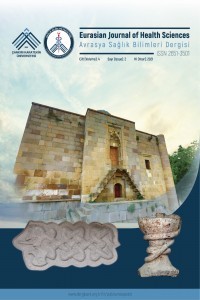Curcuma longa Ticari Ekstresinin In-Vitro Antibakteriyel Aktivitesinin Araştırılması
New plant-derived antibacterial agent researches have
increased in recent years, because of increased resistance to antimicrobial
agents that used against to pathogen microorganisms, and unwanted side effects
of food additives.
The aim of this research was to investigate the,
in-vitro antibacterial activities and minimal inhibitory concentration of Curcuma longa which obtained from India,
commercial plant extracts against some nosocomial pathogens (Extended Spectrum
Beta Lactamase Escherichia coli, Klebsiella pneumoniae, Pseudomonas aeruginosa, Enterococcus faecalis, Methicillin
Resistant Staphylococcus aureus), by
disk diffusion and broth microdilution methods.
The diameter of the inhibition zone in the
disc-diffusion method shows that Curcuma
longa extract (6.12 mg/disc) has antibacterial activity only on MRSA
(Inhibition zone diameter 8 mm). However, with broth micro dilution method, Curcuma longa extract had minimal
inhibitor concentration (4.87-78 mg/ml) on all bacteria in different levels. Curcuma longa extract showed the minimum
MIC value on S.aureus, maximum MIC
value on E.coli, K.pneumoniae and E. faecalis. The results were consistent
in both methods at equal concentrations applied from the Curcuma longa extract.
In conclusion, particularly Curcuma longa leaf extract is thought to be effective against to MRSA,
E. coli, K. pneumoniae, P. aeruginosa,
E. faecalis in many areas like medical and food industries. However,
there are need new in vivo studies in
future.
Anahtar Kelimeler:
Broth microdilution, Disk diffusion, Inhibition, Nosocomial
Investigation of In-Vitro Antibacterial Activity of Curcuma longa Commercial Extract
___
- REFERENCES 1. Almagboul AZ, Bashir AK, Farouk A, Salih AKM, (1985). Antimicrobial activity of certain Sudanese plants used in folkloric medicine. Screening for antibacterial activity. Fitoterapi, 56: 331-337. 2. Chakraborty B, Nath A, Saikia H, Sengupta M, (2014). Bactericidal activity of selected medicinal plants against multidrug resistant bacterial strains from clinical isolates. Asian Pac J Trop Med, 7 (Suppl 1): 435-441. 3. CLSI-Clinical and Laboratory Standards Institute, (2012). Methods for dilution antimicrobial susceptibility tests for bacteria that grow aerobically. Approved Standard—Ninth Ed. CLSI document M07-A9; Wayne, PA. 4. CLSI-Clinical and Laboratory Standards Institute, (2012). Performance standards for antimicrobial disk susceptibility tests; Approved Standard—Eleventh Edition. CLSI document M02-A11; Wayne, PA. 5. Conforti F, Ioele G, Statti GA, Marrelli M, Ragno G, Menichini F, (2008). Antiproliferative activity against human tumor cell lines and toxicity test on Mediterranean dietary plants. Food Chem Toxicol 46: 3325−3332 6. De O Ribeiro IC, Mariano EGA, Careli RT, Morais-Costa F, de Sant'Anna FM, Pinto MS, de Souza MR, Duarte ER, 2018. Plants of the Cerrado with antimicrobial effects against Staphylococcus spp. and Escherichia coli from cattle. BMC Vet Res, 14(1):32 7. De R, Kundu P, Swarnakar S, Ramamurthy T, Chowdhury A, Nair GB, Mukhopadhyay AK, (2009). Antimicrobial activity of curcumin against Helicobacter pylori isolates from India and during infections in mice. Antimicrobial Agents and Chemotherapy, 53, 1592–1597. 8. Jagetia GC, Aggarwal BB, (2007). “Spicing up” of the immune system by curcumin. Journal of Clinical Immunology, 27, 19–35. 9. Keskın D, Ceyhan N, Uğur A, and Durgan Dbeys A, (2012). Antimicrobial activity and chemical constitutions of West Anatolian olive. Journal of Food, Agriculture& Environment, 10(2), 99-102. 10. Lee OH, Lee BY, (2010). Antioxidant and antimicrobial activities of individual and combined phenolics in Olea europaea leaf extract. Bioresource Technology, 101, 3751–3754. 11. Marasini BP, Baral P, Aryal P, Ghimire KR, S Neupane S, Dahal N, Singh A, Ghimire L, and Shrestha K, (2015). Evaluation of Antibacterial Activity of Some Traditionally Used Medicinal Plants against Human Pathogenic Bacteria. BioMed Research International, Article ID 265425. 12. Mun SH, Joung DK, Kim YS, Kang OH, Kim SB, Seo YS, Kim YC, Lee DS, Shin DW, Kweon KT, Kwon DY, (2013). Synergistic antibacterial effect of curcumin against methicillin-resistant Staphylococcus aureus. Phytomedicine 20, 714– 718. 13. Na HS, Cha MH, Oh DR, Cho CW, Rhee JH, and Kim YR, (2011). Protective mechanism of curcumin against Vibrio vulnificus infection, FEMS Immunology&Medical Microbiology, 63, 355–362. 14. Polatoglu K, Demirci F, Demırcı B, Goren N, and Baser KHC, 2010. Antibacterial activity and the variation of Tanacetum parthenium (L.) Schultz Bip. essential oils from Turkey J Oleo Sci, 59(4), 177-184 15. Rudrappa T, Bais HP, (2008). Curcumin, a known phenolic from Curcuma longa, attenuates the virulence of Pseudomonas aeruginosa PAO1 in who leplantand animal pathogenicity models. Journal of Agriculturaland Food Chemistry, 56, 1955–1962. 16. Saleem M, Danıel B, Murlı K, (2011). Antimicrobial activity of three different rhizomes of Curcuma longa & curcuma aromatica on uropathogens of diabetic patients. Int J Pharm Pharm Sci 3(4), 273-279. 17. Samy RP, Gopalakrishnakone P, (2010). Therapeutic potential of plants as anti-microbials for drug discovery. Evid Based Complement Alternat Med 7, 283-294. 18. Shishodia S, Sethi G, Aggarwal BB, (2005). Curcumin: getting back to the roots. Annals of the New York Academy of Science, 1056, 206–217. 19. Singh R, Chandra R, Bose M, and Luthra PM, (2002). Antibacterial activity of Curcuma longa rhizome extract on pathogenic bacteria. Current Science, 83,737-740
- Yayın Aralığı: Yılda 3 Sayı
- Başlangıç: 2018
- Yayıncı: Çankırı Karatekin Üniversitesi
Sayıdaki Diğer Makaleler
Bir Nutrasötik Olarak Borun Kemik Metabolizması Üzerine Etkileri
Tünay KONTAŞ AŞKAR, Hilal ER, Ruken Esra DEMİRDÖĞEN
Sağlık Yönüyle Vegan/Vejetaryenlik
Curcuma longa Ticari Ekstresinin In-Vitro Antibakteriyel Aktivitesinin Araştırılması
Şinasi AŞKAR, Şeyma Nur DEVEBOYNU
Suda Toxoplasma gondii Analizi ve Yeni Bir Yaklaşım: İlmiğe Dayalı İzotermal Amplifikasyon Tekniği
Banuçiçek YÜCESAN, Özcan ÖZKAN
Çocuğa Yönelik İstismar ve Çözüm Önerileri
Nazan KAYTEZ, Seçil YÜCELYİĞİT, Gül KADAN
